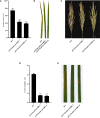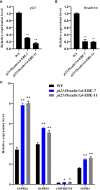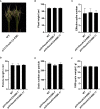Improvement of resistance to rice blast and bacterial leaf streak by CRISPR/Cas9-mediated mutagenesis of Pi21 and OsSULTR3;6 in rice (Oryza sativa L.)
- PMID: 37528980
- PMCID: PMC10389665
- DOI: 10.3389/fpls.2023.1209384
Improvement of resistance to rice blast and bacterial leaf streak by CRISPR/Cas9-mediated mutagenesis of Pi21 and OsSULTR3;6 in rice (Oryza sativa L.)
Abstract
Rice (Oryza sativa L.) is a staple food in many countries around the world, particularly in China. The production of rice is seriously affected by the bacterial leaf streak and rice blast, which can reduce rice yield or even cause it to fail to be harvested. In this study, susceptible material 58B was edited by CRISPR/Cas9, targeting a target of the Pi21 gene and a target of the effector-binding element (EBE) of the OsSULTR3;6 gene, and the mutants 58b were obtained by Agrobacterium-mediated method. The editing efficiency of the two targets in the T0 generation was higher than 90.09%, the homozygous mutants were successfully selected in the T0 generation, and the homozygous mutation rate of each target was higher than 26.67%. The expression of the edited pi21 and EBE of Ossultr3;6 was significantly reduced, and the expression of defense responsive genes was significantly upregulated after infected with rice blast. The lesion areas of rice blast and bacterial leaf streak were significantly reduced in 58b, and the resistance of both was effectively improved. Furthermore, the gene editing events did not affect the agronomic traits of rice. In this study, the resistance of 58b to rice blast and bacterial leaf streak was improved simultaneously. This study provides a reference for using Clustered Regularly Interspaced Short Palindromic Repeats/Cas9 (CRISPR/Cas9) to accelerate the improvement of rice varieties and the development of new materials for rice breeding.
Keywords: CRISPR/Cas9; OsSULTR3;6; Pi21; bacterial leaf streak; rice; rice blast.
Copyright © 2023 Yang, Fang, Wu, Zhao, Guo, Mackon, Peng, Huang, He, Qin, Liu, Liu, Chen and Li.
Conflict of interest statement
Author SC was employed by the company Guangxi Lvhai Seed Co., Ltd. The remaining authors declare that the research was conducted in the absence of any commercial or financial relationships that could be construed as a potential conflict of interest.
Figures







Similar articles
-
Enhanced Rice Blast Resistance by CRISPR/Cas9-Targeted Mutagenesis of the ERF Transcription Factor Gene OsERF922.PLoS One. 2016 Apr 26;11(4):e0154027. doi: 10.1371/journal.pone.0154027. eCollection 2016. PLoS One. 2016. PMID: 27116122 Free PMC article.
-
Knockout of Pi21 by CRISPR/Cas9 and iTRAQ-Based Proteomic Analysis of Mutants Revealed New Insights into M. oryzae Resistance in Elite Rice Line.Genes (Basel). 2020 Jul 2;11(7):735. doi: 10.3390/genes11070735. Genes (Basel). 2020. PMID: 32630695 Free PMC article.
-
Engineering of rice varieties with enhanced resistances to both blast and bacterial blight diseases via CRISPR/Cas9.Plant Biotechnol J. 2022 May;20(5):876-885. doi: 10.1111/pbi.13766. Epub 2022 Jan 14. Plant Biotechnol J. 2022. PMID: 34890109 Free PMC article.
-
CRISPR-Cas technology based genome editing for modification of salinity stress tolerance responses in rice (Oryza sativa L.).Mol Biol Rep. 2021 Apr;48(4):3605-3615. doi: 10.1007/s11033-021-06375-0. Epub 2021 May 5. Mol Biol Rep. 2021. PMID: 33950408 Review.
-
Genome edited wheat- current advances for the second green revolution.Biotechnol Adv. 2022 Nov;60:108006. doi: 10.1016/j.biotechadv.2022.108006. Epub 2022 Jun 19. Biotechnol Adv. 2022. PMID: 35732256 Review.
Cited by
-
Use of CRISPR Technology in Gene Editing for Tolerance to Biotic Factors in Plants: A Systematic Review.Curr Issues Mol Biol. 2024 Oct 2;46(10):11086-11123. doi: 10.3390/cimb46100659. Curr Issues Mol Biol. 2024. PMID: 39451539 Free PMC article. Review.
-
Molecular Basis of Plant-Pathogen Interactions in the Agricultural Context.Biology (Basel). 2024 Jun 6;13(6):421. doi: 10.3390/biology13060421. Biology (Basel). 2024. PMID: 38927301 Free PMC article. Review.
-
Recent advances of CRISPR-based genome editing for enhancing staple crops.Front Plant Sci. 2024 Sep 23;15:1478398. doi: 10.3389/fpls.2024.1478398. eCollection 2024. Front Plant Sci. 2024. PMID: 39376239 Free PMC article. Review.
References
-
- Asibi A., Chai Q., Coulter J. (2019). Rice blast: a disease with implications for global food security. Agronomy 9 (8), 451. doi: 10.3390/agronomy9080451 - DOI
-
- Bossa-Castro A., Tekete C., Raghavan C., Delorean E., Dereeper A., Dagno K., et al. . (2018). Allelic variation for broad-spectrum resistance and susceptibility to bacterial pathogens identified in a rice MAGIC population. Plant Biotechnol. J. 16 (9), 1559–1568. doi: 10.1111/pbi.12895 - DOI - PMC - PubMed
-
- Cernadas R., Doyle E., Nino-Liu D., Wilkins K., Bancroft T., Wang L., et al. . (2014). Code-assisted discovery of tal effector targets in bacterial leaf streak of rice reveals contrast with bacterial blight and a novel susceptibility gene. PloS Pathog. 10 (4). doi: 10.1371/journal.ppat.1004126 - DOI - PMC - PubMed
Grants and funding
LinkOut - more resources
Full Text Sources
Other Literature Sources
Research Materials

